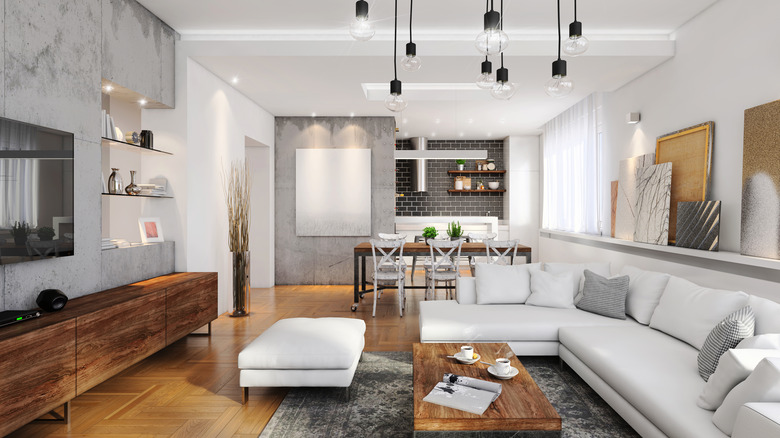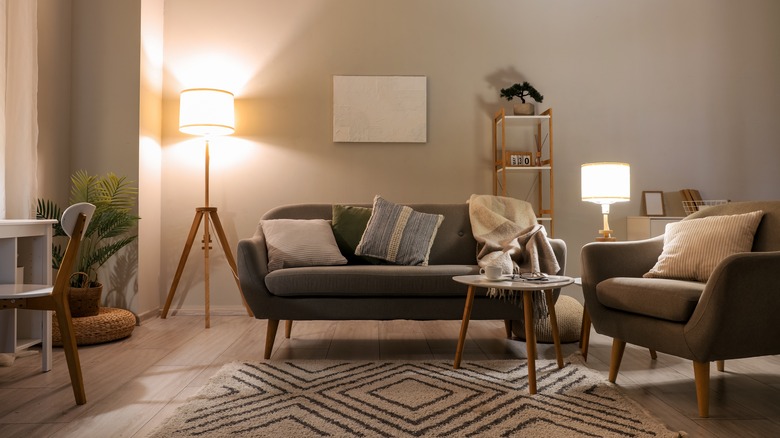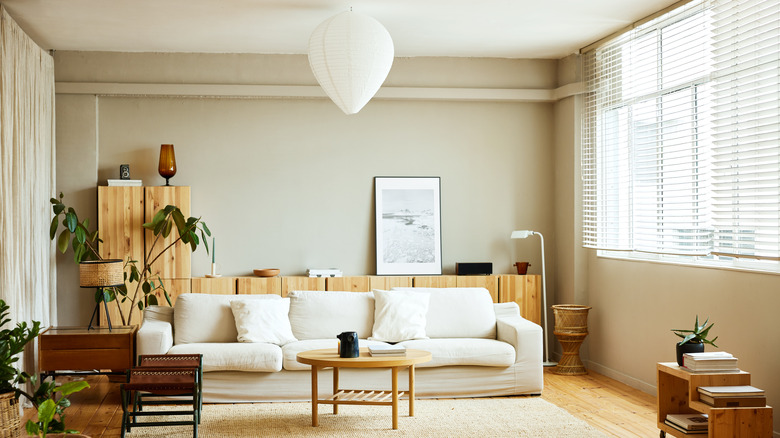Choose The Right Light Fixture To Boost Your Living Room, According To An Expert
If your family and friends tend to gather in your living room, it's important to get the mood lighting right. Having the room starkly lit makes it feel like you're sitting in an office waiting room, which doesn't exactly inspire one to sit back and relax. On the other hand, having it too dim can make it difficult to do an activity outside of watching TV, such as curling up with a book or finishing a puzzle. But getting the lighting situation right is easier said than done, especially if you're not privy to all the different lighting options on the market. That's why we turned to an interior designer for their professional opinion on what to focus on.
"Lighting might not always get the spotlight it deserves, but it's one of the unsung heroes in interior design. Imagine having a beautifully designed space that's so dimly lit you can barely see it. Tragic, right?" Brandy Rinehart, interior designer at Habitar Design, exclusively tells House Digest. "It's not just about visibility — lighting can transform a space from ordinary to extraordinary." She has a lot of ideas on how to achieve that. Surprisingly, you don't want to just focus on your overhead lighting. Instead, when choosing the perfect lighting for your space, you want to incorporate several layers of different fixtures. Here's how.
Focus on multiple lighting sources
You might think that updating your overhead lighting to something stronger will help illuminate your space better. But that would be a mistake. "If you rely solely on overhead lighting, the space might feel harsh and uninviting," Rinehart exclusively tells House Digest. "To avoid that, think creatively." This means also looking at table lamps, sconces, and tape lighting. Using all four options in the living room will not only give you plenty of watts, but you will also be able to decide how much or little light you want by turning on or off some of these options. Take side lamps, for example. "Side lamps offer ambient lighting that sets the mood and complements your design. They're perfect for cozy evenings or adding a touch of elegance," Rinehart explains.
On the other hand, sconces can add more light and pull your attention to certain parts of the room. "Adding sconces above a fireplace, next to a room entrance, or beside artwork can introduce both functional and aesthetic benefits," Rinehart explains. If you don't have the budget to wire new sconces into the wall, she suggests investing in battery-operated ones that can be turned on and off with a remote control. Lastly, finish off the room with some tastefully applied tape lighting. "This versatile option can be hidden in ceiling crown molding, baseboards, or even around architectural features," she notes. This will not only set the mood in the space with its soft, diffused light, but it can also make your design appear sleeker thanks to the modern integration.
Lighting mistakes to avoid
You might think that this is overkill, opting instead to put your overhead light on a dimmer to fix the issue. However, Rinehart believes this is a mistake. "Relying on a single central fixture often leads to uneven illumination," she exclusively tells House Digest. "Layering different light sources is key." The center of the room will be blasted with light, whereas the corners and edges will be dim. That's where the table lamps, sconces, and tape lighting can help. That's why these types of lighting are essential in a living room.
Secondly, you want to make sure you're choosing fixtures that match the scale of the room. If you simply choose a design you like without thinking how it fits in with the proportions of the space, your design will come out looking wonky. "Choosing a fixture that's too large or too small for your space can disrupt the room's balance," Rinehart notes. "For instance, a grand chandelier might not suit a room with a low ceiling." However, if your heart is set on a chandelier, she suggests choosing one that's dramatic rather than huge. You can still find an eye-catching design in a smaller package.


